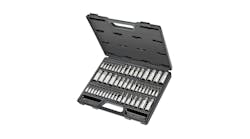The expected lifespan of tire pressure monitoring system (TPMS) sensors is between 7 and 10 years, meaning many vehicles coming into your shop are already in need or going to be in need of replacement sensors. Use this opportunity to educate your customers on the importance of the TPMS sensors – safety, vehicle awareness and peace of mind.
When you replace or recalibrate the sensors, some vehicles have dog-and-pony steps to walk through: Turn the ignition on, then off, then on and depress the brake pedal 3 times. Then let air out of each tire until the horn sounds. They work, but they’re often time-consuming and different for every vehicle, requiring you to read a service manual or look up the procedures online.
To save time, think of investing in a standalone or paired TPMS tool that can reset and relearn the sensors quickly.
OTC recently brought a new standalone OBDII TPMS tool to market with basic diagnostics capabilities. Think of it as a TPMS tool with a built-in enhanced code reader. Plug the dongle in to the CAN bus and scan each tire’s TPMS sensor. The vehicle will learn and register the sensor position and PSI almost instantly, allowing the relearn procedure to take less than 10 minutes.
The tool offers complete OEM coverage for all Domestic, Asian and European makes and models and is compatible with all aftermarket sensors including: Schrader EZ-sensor ™, VDO REDI-sensor™, HUF IntelliSens®, and Alligator Sens.it®.
Tire failures cause approximately 11,000 crashes a year in the United States, according to the National Highway Traffic Safety Administration (NHTSA). If your customers are riding on worn or under inflated tires they can experience reduced braking effectiveness and increase the likelihood and severity of an accident.
So educate your customers on proper tire maintenance and the importance of not ignoring in-dash warning lights. Keeping their safety top of mind and getting their car fixed faster will only continue to strengthen your relationship as well as ensuring the safety of others on the road.



